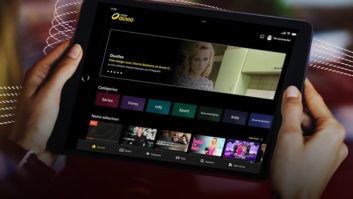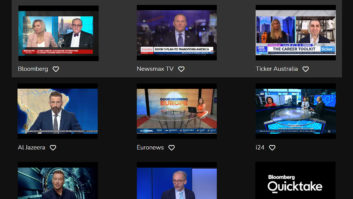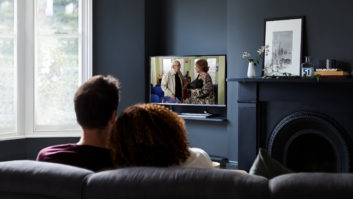Five years ago, the ambition to have more mobile, personalised, interactive video content would, ironically, have been dismissed as OTT. Today, the future is OTT. And if analysts are to be believed, it’s now the broadcast mainstream.
Today, with the on-demand economy tipped to reach $57 billion in 2018, OTT has taken on a new meaning that’s redefining TV. With traditional broadcast seemingly reaching its final episodes, it’s time to go OTT – or go nowhere.
In a fast-paced marketplace where the battle for audience is intense, many networks and operators now see OTT as the golden ticket to competitive advantage. However, where previously they may have outsourced delivery, many are now looking to establish their own infrastructure having struggled with the lack of flexibility and velocity on third party roadmaps.
Faced with an unforgiving commercial conundrum, providers are evaluating whether to ‘buy or build’, and they’re increasingly choosing the DIY option. But it isn’t easy. Organisations need help. Innovation is essential.
The move to OTT
The change is already happening. In the UK, the growth of video streaming services like Netflix and Amazon is forcing the hand of established broadcasters. In the next 12 months Sky plans a roll out of IPTV that will move its services ‘beyond the dish’. The BBC, ITV and Channel 4 have been slowly going OTT for quite some time and have recently announced plans to collaborate further.
At the same time, on the global stage, media companies like Disney and Discovery are looking to cut out the middle-man and go direct-to-consumer with their own digital streaming services. A 2018 report by the Diffusion Group predicts that all major TV networks will offer DTC streaming services by 2022.
This change is being driven by the MilleXZials. If you’ve never heard of them, you might be surprised: you’re most likely one of the gang. Because according to a 2018 Deloitte report, the fanatical adopters of digital media are not just Gen Z and Millennials, they’re also the 35-51 year olds camped out in Generation X. We’re all in it together. And our collective demand for the TV we want, wherever and whenever we want it, is redefining consumer expectations and forcing traditional broadcasters to rethink their business models.
The question is, how can service providers make the move to OTT and bring together the right skill sets that will help to create a seamless OTT experience for everyone?
Universally challenged
Building a sustainable platform for OTT services is complex, requiring infrastructure, architecture and knowhow that’s unfamiliar to most traditional operators. Making the quantum leap from video to a software-oriented domain demands expertise across all the multiple components of a diverse end-to-end process; from streaming languages, video formats, IP networks and encryption to content delivery platforms, transcoding, digital permissions and device-specific UI. These are specialisms in their own right – and they require specialist skills that, at present, many providers just don’t have in-house.
This complex end-to-end process dictates distinct skillsets that combine video, software design and traditional IT. It’s a skill mix that’s challenging CTOs as they look to establish an efficient and sustainable infrastructure for OTT. There’s much to consider.
So how are companies currently approaching it? Some have contemplated morphing the key attributes of the individual disciples into one single role. But the hybrid person is a mythical beast: it doesn’t exist. Identifying individuals that possess the composite capabilities is, at present, unlikely; the skill mix is too broad and deep.
To overcome this, some organisations are upskilling their workforce to re-arm traditional roles with modern tools and techniques. There’s no doubt that training is both positive and essential, particularly as companies wait for the next generation of appropriately-qualified talent to come through. However, it’s not an overnight fix. Upskilling is a slow process that can still leave gaps in knowledge that hold back progress. In the competitive on demand economy, speed to market is essential.
The most progressive organisations are partnering with media technology experts to create the right roadmap for the journey. The best partners will understand the complexities of building service provider grade video platforms. And they’ll have worldwide experience of working with studios, content providers, broadcasters and licensees to establish sustainable integrated architecture for delivering video OTT.
Time to change
The DIY approach to building OTT infrastructure is a logical step for the industry. However, organisations that believe they can take their existing set-up and port it to the Cloud will invariably end up making some big mistakes. The software-oriented world is a very different environment to the one in which companies have historically operated.
As the industry awaits the next generation of talent, a willingness to partner with experts that understand how to build successful video services in the Cloud could be the key to unlocking competitive advantage.
The drivers for change are compelling; consumers’ appetite for watching video on demand over digital and mobile devices is both insatiable and unrelenting. It’s no surprise that traditional players are jettisoning long-standing business models and gearing up to join the world of OTT. Their philosophy is sensible: build it, and they will come. But building it is a whole new ball game. So if you want to attract the MilleXZials, find the right partners and build it properly, you might just hit it out the park.







